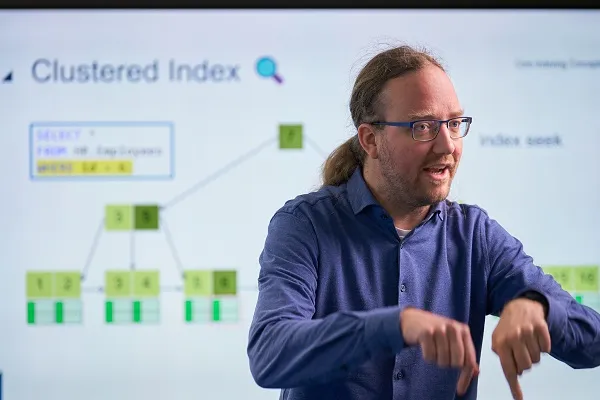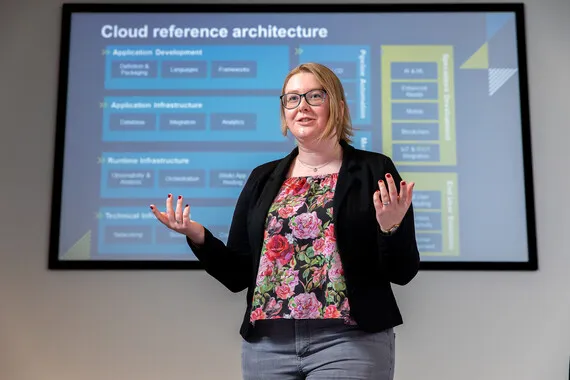course
Microsoft Fabric Analytics Engineer (DP-600)
Learn to use Microsoft Fabric in every stage of your data analytics journey

Description
This course covers methods and practices for implementing and managing enterprise-scale data analytics solutions using Microsoft Fabric. Students will build on existing analytics experience and will learn how to use Microsoft Fabric components, including lakehouses, data warehouses, notebooks, dataflows, data pipelines, and semantic models, to create and deploy analytics assets.
The primary audience for this course is data professionals with experience in data modeling, extraction, and analytics. DP-600 is designed for professionals who want to use Microsoft Fabric to create and deploy enterprise-scale data analytics solutions.
This course also prepares for exam DP-600: Implementing Analytics Solutions Using Microsoft Fabric and earn certification Microsoft Certified: Fabric Analytics Engineer Associate
Exam voucher is not included.
Prior Knowledge
Experience with:
- Microsoft Power BI Power BI Data Analyst
- Querying T-SQL Core Querying Data with T-SQL
- Basic Python Essentials of Python Development
Subjects
1: Introduction to end-to-end analytics using Microsoft Fabric
Discover how Microsoft Fabric can meet your enterprise's analytics needs in one platform. Learn about Microsoft Fabric, how it works, and identify how you can use it for your analytics needs.
Lessons
- Describe end-to-end analytics in Microsoft Fabric
2: Administer Microsoft Fabric
Microsoft Fabric is a SaaS solution for end-to-end data analytics. As an administrator, you can configure features and manage access to suit your organization's needs.
Lessons
- Describe Fabric admin tasks
- Navigate the admin center
- Manage user access
3: Ingest Data with Dataflows Gen2 in Microsoft Fabric
Data ingestion is crucial in analytics. Microsoft Fabric's Data Factory offers Dataflows for visually creating multi-step data ingestion and transformation using Power Query Online.
Lessons
- Describe Dataflow capabilities in Microsoft Fabric
- Create Dataflow solutions to ingest and transform data
- Include a Dataflow in a pipeline
4: Ingest data with Spark and Microsoft Fabric notebooks
Discover how to use Apache Spark and Python for data ingestion into a Microsoft Fabric lakehouse. Fabric notebooks provide a scalable and systematic solution.
Lessons
- Ingest external data to Fabric lakehouses using Spark
- Configure external source authentication and optimization
- Load data into lakehouse as files or as Delta tables
5: Use Data Factory pipelines in Microsoft Fabric
Microsoft Fabric includes Data Factory capabilities, including the ability to create pipelines that orchestrate data ingestion and transformation tasks.
Lessons
- Describe pipeline capabilities in Microsoft Fabric
- Use the Copy Data activity in a pipeline
- Create pipelines based on predefined templates
- Run and monitor pipelines
6: Get started with lakehouses in Microsoft Fabric
Lakehouses merge data lake storage flexibility with data warehouse analytics. Microsoft Fabric offers a lakehouse solution for comprehensive analytics on a single SaaS platform.
Lessons
- Describe core features and capabilities of lakehouses in Microsoft Fabric
- Create a lakehouse
- Ingest data into files and tables in a lakehouse
- Query lakehouse tables with SQL
7: Organize a Fabric lakehouse using medallion architecture design
Explore the potential of the medallion architecture design in Microsoft Fabric. Organize and transform your data across Bronze, Silver, and Gold layers of a lakehouse for optimized analytics.
Lessons
- Describe the principles of using the medallion architecture in data management.
- Apply the medallion architecture framework within the Microsoft Fabric environment.
- Analyze data stored in the lakehouse using DirectLake in Power BI.
- Describe best practices for ensuring the security and governance of data stored in the medallion architecture.
8: Use Apache Spark in Microsoft Fabric
Apache Spark is a core technology for large-scale data analytics. Microsoft Fabric provides support for Spark clusters, enabling you to analyze and process data in a Lakehouse at scale.
Lessons
- Configure Spark in a Microsoft Fabric workspace
- Identify suitable scenarios for Spark notebooks and Spark jobs
- Use Spark dataframes to analyze and transform data
- Use Spark SQL to query data in tables and views
- Visualize data in a Spark notebook
9: Work with Delta Lake tables in Microsoft Fabric
Tables in a Microsoft Fabric lakehouse are based on the Delta Lake storage format commonly used in Apache Spark. By using the enhanced capabilities of delta tables, you can create advanced analytics solutions.
Lessons
- Understand Delta Lake and delta tables in Microsoft Fabric
- Create and manage delta tables using Spark
- Use Spark to query and transform data in delta tables
- Use delta tables with Spark structured streaming
10: Get started with data warehouses in Microsoft Fabric
Data warehouses are analytical stores built on a relational schema to support SQL queries. Microsoft Fabric enables you to create a relational data warehouse in your workspace and integrate it easily with other elements of your end-to-end analytics solution.
Lessons
- Describe data warehouses in Fabric
- Understand a data warehouse vs a data Lakehouse
- Work with data warehouses in Fabric
- Create and manage fact tables and dimensions within a data warehouse
11: Load data into a Microsoft Fabric data warehouse
Data warehouse in Microsoft Fabric is a comprehensive platform for data and analytics, featuring advanced query processing and full transactional T-SQL capabilities for easy data management and analysis.
Lessons
- Learn different strategies to load data into a data warehouse in Microsoft Fabric.
- Learn how to build a data pipeline to load a warehouse in Microsoft Fabric.
- Learn how to load data in a warehouse using T-SQL.
- Learn how to load and transform data with dataflow (Gen 2).
12: Query a data warehouse in Microsoft Fabric
Data warehouse in Microsoft Fabric is a comprehensive platform for data and analytics, featuring advanced query processing and full transactional T-SQL capabilities for easy data management and analysis.
Lessons
- Use SQL query editor to query a data warehouse.
- Explore how visual query editor works.
- Learn how to connect and query a data warehouse using SQL Server Management Studio.
13: Monitor a Microsoft Fabric data warehouse
A data warehouse is a vital component of an enterprise analytics solution. It's important to learn how to monitor a data warehouse so you can better understand the activity that occurs in it.
Lessons
- Monitor capacity unit usage with the Microsoft Fabric Capacity Metrics app.
- Monitor current activity in the data warehouse with dynamic management views.
- Monitor querying trends with query insights views.
14: Understand scalability in Power BI
Scalable data models enable enterprise-scale analytics in Power BI. Implement data modeling best practices, use large dataset storage format, and practice building a star schema to design analytics solutions that can scale.
Lessons
- Describe the importance of building scalable data models
- Implement Power BI data modeling best practices
- Use the Power BI large dataset storage format
15: Create Power BI model relationships
Power BI model relationships form the basis of a tabular model. Define Power BI model relationships, set up relationships, recognize DAX relationship functions, and describe relationship evaluation.
Lessons
- Understand how model relationship work.
- Set up relationships.
- Use DAX relationship functions.
- Understand relationship evaluation.
16: Use tools to optimize Power BI performance
Use tools to develop, manage, and optimize Power BI data model and DAX query performance.
Lessons
- Optimize queries using performance analyzer.
- Troubleshoot DAX performance using DAX Studio.
- Optimize a data model using Tabular Editor.
17: Enforce Power BI model security
Enforce model security in Power BI using row-level security and object-level security.
Lessons
- Restrict access to Power BI model data with RLS.
- Restrict access to Power BI model objects with OLS.
- Apply good development practices to enforce Power BI model security.
Schedule
| Start date | Duration | Location | |
|---|---|---|---|
April 20, 2026April 21, 2026April 22, 2026April 23, 2026 | 4 days | Utrecht / Remote This is a hybrid training and can be followed remotely. More information Utrecht / Remote This is a hybrid training and can be followed remotely. More information Utrecht / Remote This is a hybrid training and can be followed remotely. More information Utrecht / Remote This is a hybrid training and can be followed remotely. More information | Sign up |
All courses can also be conducted within your organization as customized or incompany training.
Our training advisors are happy to help you provide personal advice or find Incompany training within your organization.
Trainers
Prior knowledge courses
Microsoft Power BI Data Analyst (PL-300)
Build quick, effective and interactive visuals, reports and dashboards to analyse your data.
- Business Intelligence
Core Querying Data with Transact-SQL (DP-080)
Learn the Transact SQL language to query SQL Server or Azure data sources
- Databases
Python Fundamentals
Attain a solid foundation of Python for developing software solutions
- Python
Certification
The knowledge from this training aligns with these certifications.
"Trainer who knows his profession!"Marc
-
Hoge waardering
-
Praktijkgerichte trainingen
-
Gecertificeerde trainers
-
Eigen docenten





